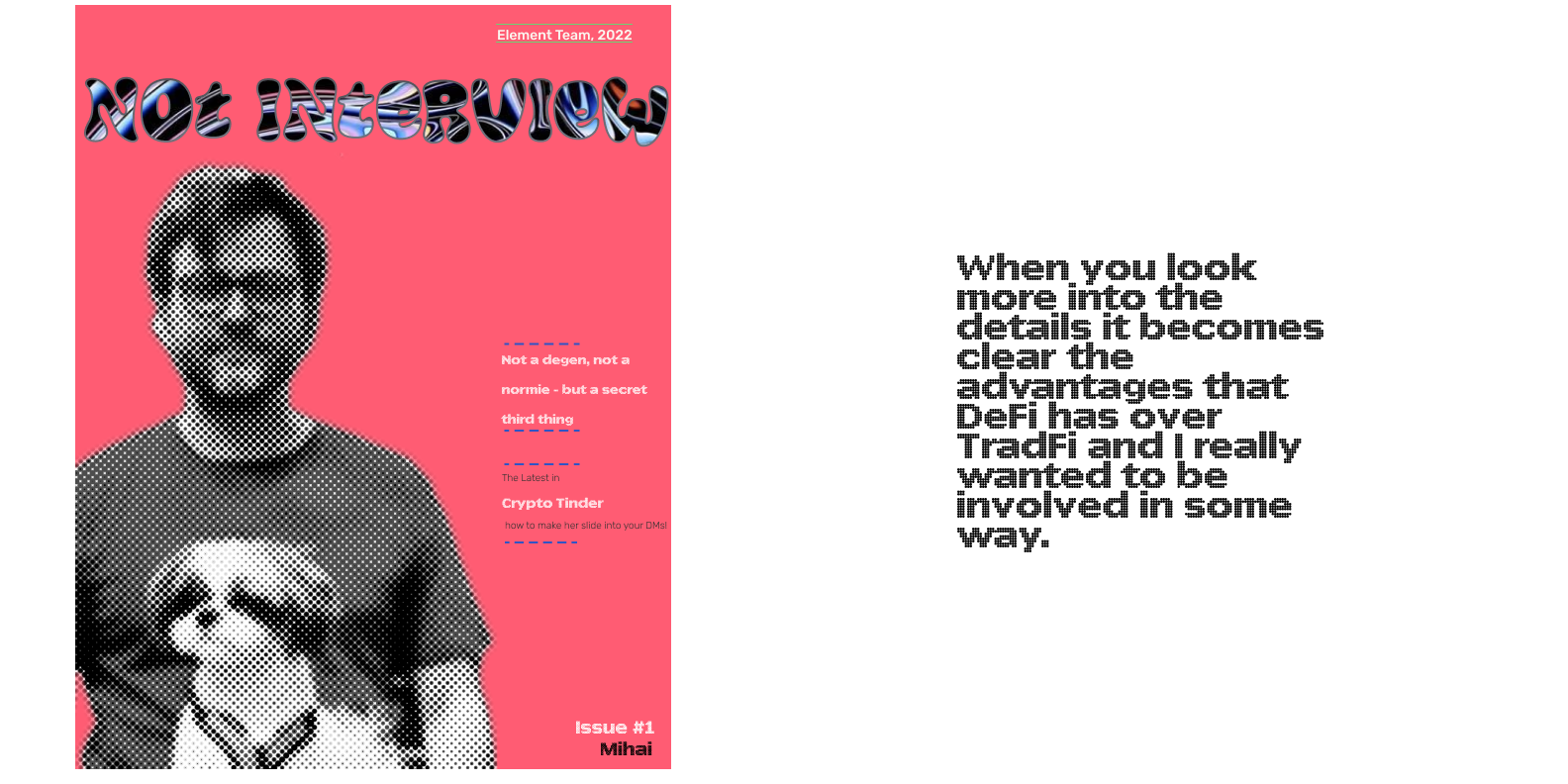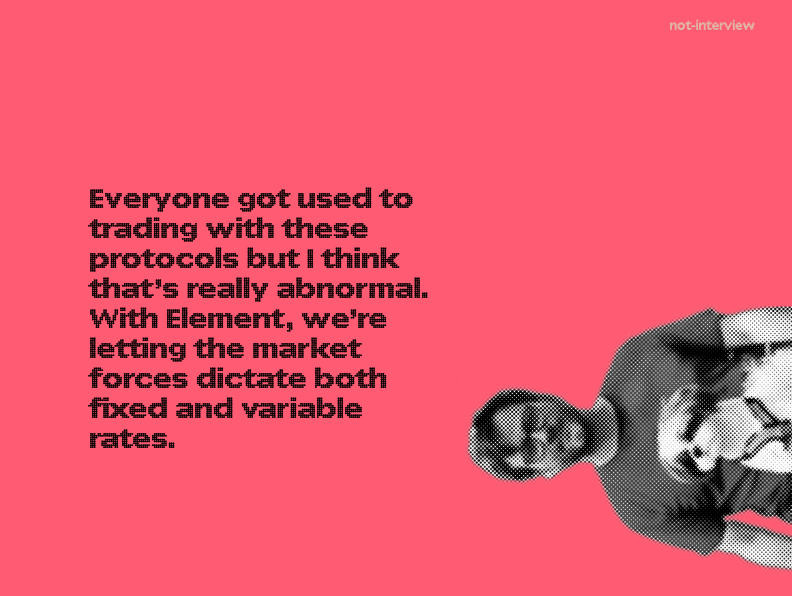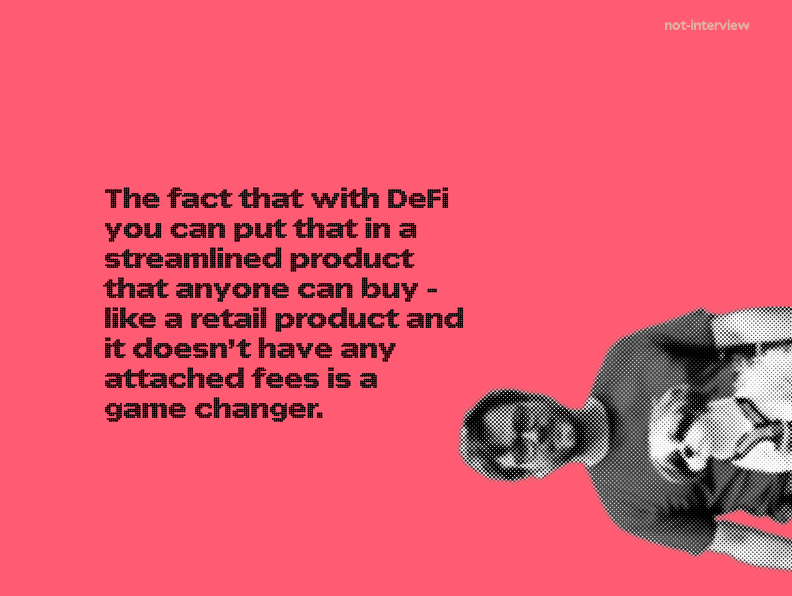Mihai Cosma: Not Interview

This interview is part of a series we’ve dubbed “Not Interviews” where we give you a peek behind the curtain of Element Labs - introducing you to the team as well as how they’re thinking about the space. In today’s series, we meet Mihai Cosma - DeFi Strategist at Element.
Rapid Fire
- Better boss - Jonny or Will? Will for ideation, Jonny for execution
- Remote work or a huge office in your fav city? Remote work, can't beat rolling out of bed
- 1 million severance pay or opportunity to work in element but with a cut salary Wait, you guys get paid??
- Classical music or techno? The deafening silence of mediocrity
- Netflix or HBO? Netflix's Drive To Survive!
- Restaurants or home food? Home food made from meal kits
- Digital nomad lifestyle or be settled down? some mix: 2 weeks travel, 1 month home?
- DAI or USDC? DAI
- Wealth or family? Leaving a lasting influence on the world
Tell us a little about your background
I have a bachelor's in financial economics. I was always more focused on the finance side rather than economics but I don't really think of myself as an economist. I worked in the Bank of Canada for 11 years which maybe plays into that economist stereotype.
Specifically, I was in the financial markets department, which is not one of the ones that's hardcore economics. I think there are four departments that have more classic setups that hire full economic PhDs - doing papers and primary economic analysis leading to setting monetary policy while my group was more interested in market monitoring.
Half of my role was briefing management on what's happening within the developed fixed income markets and the other half was managing our foreign reserves - more of an asset management focus. Think Blackrock or Vanguard where we’re sitting on top of very boring fixed income assets and managing them but from the government’s perspective.
How does the BoC look at risk management?
Everything we looked at was very low risk, by definition everything there’s built for the most safety from the ground up so that means fixed income only, no equities - we weren’t buying stock. Think AAA names - US Treasuries, France & German bonds, sovereign bonds, supra-nationals like the World Bank, etc. - the 20 to 30 names that issue debt globally.
Even among our peers we were one of the most risk averse. Exposure to interest rates levels, we kept to near zero - if rates go up or down that wasn’t an issue for us. We did this by hedging pretty aggressively - both to rate levels and FX risk.
So if the Euro rate changes that doesn’t affect the BoC’s balance sheet a whole lot as it hits both the asset and liabilities side. What we ended up with was really much more micro risks around security selection rather than the big macro risks you typically see in the news.
How do you get into crypto?
I was just following it out of sheer curiosity but only got super interested in it maybe around the end of 2020 and then last year (2021) it became like an obsession and I was spending all my time learning, thinking about it and exploring different protocols.
It was only when I really started seeing the use cases around DeFi that I really got excited about it. One of the first things I came across was Harvest Finance in the aftermath of it blowing up. People kind of talked about the hack and thought it was dumb but I approached it from the perspective of how does this protocol go from zero AUM to $1B in about a month.
Clearly something very novel was happening with a lot of possibilities as long as you don’t get hacked. When you look more into the details it becomes clear the advantages that DeFi has over TradFi and I really wanted to be involved in some way.

What are the advantages of DeFi vs TradFi?
TradFi is kind of the opposite of open-source or composability culture - where you want to come up with your best ideas and hoard them internally and not tell anyone about them. There’s no collaboration, there’s no openness, there’s no building on top of each other. It’s all very frustrating - everyone is building everything separately and independently with a lot of duplicated effort and inferior results.
A lot of these places have huge IT staff like we did at the bank where it was the biggest department and they were just building on inefficient and old tech stacks that really don’t let them do anything novel - add in bloat and they move painfully slowly.
I have a background in computer science and spent some time playing around with open source chess bots - like basically trying to do what DeepMind did. You just have a bunch of nerds jamming on Discord trying to push the boundaries of what is possible but you’d never see that type of collaboration in TradFi - the way open-source communities comes together.
Lastly, in traditional finance you’re forced into building huge economies of scale as you have all these fixed costs like logistical overhead as well as razor thin margins so you have to be operating at billions in AUM. You can't go out there and create a startup bank. You just can't compete while working at a smaller scale. And without competition you have no incentive to innovate and you’re basically doing the same things that you did in the 80s.
How do you see crypto evolving?
The intersection of DeFi and traditional financial services is really hard to tell right now. They service completely distinct clients - like a bank has to cater to your 80 year old Grandma who walks in and doesn’t have a phone. In DeFi, the barrier is a lot higher - you need to be tech savvy to manage all the security and self-custody wallets - it’s a difficult mess right now.
One of the things that is really being pushed now is account abstraction which should make wallets a lot more manageable and customizable - sort of like using Robinhood. But I don’t see us replacing RBC for instance but instead maybe the banks incorporate pieces of DeFi to help streamline their offering while using Ethereum or another layer under the hood.
What are you excited about being built right now?
I’m most excited to see financial products that simply wouldn’t exist in TradFi or even new use cases for traditional products even if it’s for a more niche audience like degen tech savvy crypto natives. Squeeth is a good example because you get a squared payout and that doesn’t exist in TradFi and that’s a pretty complicated product.
The fact that with DeFi you can put that in a streamlined product that anyone can buy - like a retail product and it doesn’t have any attached fees is a game changer.
Tell me a little about PvP markets?
I think that’s a really cool theme that Element does well and other protocols kind of lack. Every market is TradFi is structured the same way with it being People vs People. Like you go into a food market and there are 10 stalls sitting there and say 100 customers and then it’s just buyers versus sellers interacting directly.
Many protocols are really the opposite where they centralize all of it and it’s hard coded into the contracts or it’s updated by governance. When you go to Compound or Maker you’re taking their rates but who is to say that is the correct rate. Say 20% utilization means a 4% rate which looked great before inflation blew up and the Fed started hiking but now it looks terrible.
Everyone got used to trading with these protocols but I think that’s really abnormal - you don’t go and trade with the New York Stock Exchange. They're not a counter-party, they don't tell you what the price of that stock is - it’s the participants in the market. With Element, we’re letting the market forces dictate both fixed and variable rates.
What about synthetic markets vs real markets?
The big one is SNX and they can really list anything - think Tesla stock or the Euro and all they need is a price lookup. You’re really placing a bet on the price and the stakers are taking the other side of the trade. With this flexible structure, they can list any instrument including Tesla without actually having to have people deposit the stock.
This second layer on top of actual trading is again not an actual market - you’re not trading real stock and all sorts of bad things can happen as we saw with MBS in 2007. For that to work it can’t be the dominant market - imagine if everyone trading Tesla stock jumped to this derivative market - suddenly big vol moves can happen breaking this second order market.
That dynamic of user vs user is core to Element as we’re not a debt platform - we don’t take anyone's money or lend tokens out - you’re never actually going through Element. It’s a traditional market where two parties can get together and you’re trading real assets albeit locked up for a future duration.

How does product market fit work for DeFi?
I think if you look at something that works in TradFi, you have to ask why is it working? What purpose is it serving and do we even need it in DeFi. Sometimes that answer might be yes but other times it might be non-transferrable and/or a relic of inefficiencies which can be better served with new tools.
The thought process shouldn’t be that there's this big market and let’s simply copy it over, which I think is how people look at the quadrillion dollar fixed rate market. I think we should go back to first principles and look at the problems we’re trying to address with this instrument.
We’re lucky in that respect, at Element as our founders come from a research background and have a history of building from the ground up. So yes, we want to cater to early crypto adopters but looking forward I’m more interested in finding product market fit with the next billion people that haven’t even been exposed to DeFi yet.
Are rates sustainable and how can they be?
The way they are now they are not super sustainable but I think people are having this conversation and we’ve gotten a lot better at it. A lot of protocols have moved away from liquidity mining as a big source of yields, which for Compound and Aave used to be a big part of their offer as returns were subsidized with token emissions.
This is a big culture shift for DeFi in moving away from token emissions which is good because that part is not sustainable. Neither is leveraged trading where the funding rate is the source of yield but mostly disappears in bear markets. It will always be there in some capacity but it's not the best foundation on which to build sustainable growth.
The other source being explored are real world assets where you could be funding people’s mortgages using crypto or making traditional assets investable through DeFi. But then you’re really just copying TradFi and you lose that magic of building our ecosystem while bolting on all the risks of that world.
I think there could be a happy medium in between where you allow a convergence or interaction between the two worlds. For instance, it was really bad when real world rates are going up, Compound and Aave rates are going down, because there's no interlinkage between them. I could see primitives being built even through Element that facilitates that interaction through a market mechanism where different assets encapsulate the risk.
Join Our Community! 🧝
We want to hear from you! You can always ask questions in our Discord if you are interested in providing feedback, reviewing our code, or just want to learn more.
Twitter | Discord | Website | Github | Docs
This content is provided for informational purposes only, and should not be relied upon as legal, business, investment, or tax advice. You should consult your own advisers as to those matters. References to any securities or digital assets are for illustrative purposes only and do not constitute an investment recommendation or offer to provide investment advisory services. Furthermore, this content is not directed at nor intended for use by any investors or prospective investors, and may not under any circumstances be relied upon when making a decision to invest in any fund or financial instrument.
The charts and graphs provided within are for informational purposes solely and should not be relied upon when making any investment decision. Past performance is not indicative of future results. The content speaks only as of the date indicated. Any projections, estimates, forecasts, targets, prospects, and/or opinions expressed in these materials are subject to change without notice and may differ or be contrary to opinions expressed by others.

